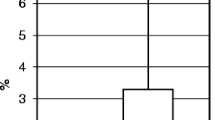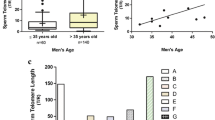Abstract
Purpose
Telomeres are multifunctional nucleoprotein domains with hexanucleotide tandem repeat (5′ TTAGGG 3′) sequences, which cap the chromosome ends. However, the role of telomere and its length in sperm with regard to fertility remains unknown.
Methods
In this pilot study, we analyzed 32 idiopathic infertile men and 25 controls for sperm telomere length by quantitative polymerase chain reaction (Q-PCR), and correlated it with sperm DNA fragmentation index (DFI) and reactive oxygen species (ROS) levels.
Results
The relative sperm mean telomere length (T/S) of infertile men was found to be significantly lower (p < 0.005) when compared to controls (0.674 ± 0.028 vs. 0.699 ± 0.030). None of the sperm parameters such as sperm count, forward motility, morphology, ROS, and DFI were found to correlate with the sperm telomere length.
Conclusion
Shorter telomeres in sperm may be one of the causative factors responsible for male infertility, but further detailed studies are needed to confirm these findings.



Similar content being viewed by others
Abbreviations
- DFI:
-
DNA fragmentation index
- ROS:
-
Reactive oxygen species
- SCSA:
-
Sperm chromatin structure assay
- Q-PCR:
-
Quantitative PCR
References
Singh K, Jaiswal D (2011) Human male infertility: a complex multifactorial phenotype. Reprod Sci 18(5):418–425. doi:10.1177/1933719111398148
Venkatesh S, Thilagavathi J, Kumar K, Deka D, Talwar P, Dada R (2011) Cytogenetic, Y chromosome microdeletion, sperm chromatin and oxidative stress analysis in male partners of couples experiencing recurrent spontaneous abortions. Arch Gynecol Obstet 284(6):1577–1584. doi:10.1007/s00404-011-1990-y
Shamsi MB, Venkatesh S, Pathak D, Deka D, Dada R (2011) Sperm DNA damage & oxidative stress in recurrent spontaneous abortion (RSA). Indian J Med Res 133(5):550–551 IndianJMedRes_2011_133_5_550_81674 [pii]
Thilagavathi J, Venkatesh S, Dada R (2012) Telomere length in reproduction. Andrologia (in press)
Treff NR, Su J, Taylor D, Scott RT Jr (2011) Telomere DNA deficiency is associated with development of human embryonic aneuploidy. PLoS Genet 7(6):e1002161. doi:10.1371/journal.pgen.1002161
Andrews NP, Fujii H, Goronzy JJ, Weyand CM (2010) Telomeres and immunological diseases of aging. Gerontology 56(4):390–403. doi:10.1159/000268620
Siderakis M, Tarsounas M (2007) Telomere regulation and function during meiosis. Chromosome Res 15(5):667–679. doi:10.1007/s10577-007-1149-7
Erenpreiss J, Spano M, Erenpreisa J, Bungum M, Giwercman A (2006) Sperm chromatin structure and male fertility: biological and clinical aspects. Asian J Androl 8(1):11–29. doi:10.1111/j.1745-7262.2006.00112.x
Achi MV, Ravindranath N, Dym M (2000) Telomere length in male germ cells is inversely correlated with telomerase activity. Biol Reprod 63(2):591–598
Liu L, Blasco M, Trimarchi J, Keefe D (2002) An essential role for functional telomeres in mouse germ cells during fertilization and early development. Dev Biol 249(1):74–84 (S0012160602907359[pii])
Rodriguez S, Goyanes V, Segrelles E, Blasco M, Gosalvez J, Fernandez JL (2005) Critically short telomeres are associated with sperm DNA fragmentation. Fertil Steril 84(4):843–845. doi:10.1016/j.fertnstert.2005.05.014
Moskovtsev SI, Willis J, White J, Mullen JB (2010) Disruption of telomere–telomere interactions associated with DNA damage in human spermatozoa. Syst Biol Reprod Med 56(6):407–412. doi:10.3109/19396368.2010.502587
Scherthan H, Weich S, Schwegler H, Heyting C, Harle M, Cremer T (1996) Centromere and telomere movements during early meiotic prophase of mouse and man are associated with the onset of chromosome pairing. J Cell Biol 134(5):1109–1125
Calado RT, Young NS (2009) Telomere diseases. N Engl J Med 361(24):2353–2365. doi:10.1056/NEJMra0903373
Venkatesh S, Riyaz AM, Shamsi MB, Kumar R, Gupta NP, Mittal S, Malhotra N, Sharma RK, Agarwal A, Dada R (2009) Clinical significance of reactive oxygen species in semen of infertile Indian men. Andrologia 41(4):251–256. doi:10.1111/j.1439-0272.2009.00943.x
Cawthon RM (2002) Telomere measurement by quantitative PCR. Nucleic Acids Res 30(10):e47
Gineitis AA, Zalenskaya IA, Yau PM, Bradbury EM, Zalensky AO (2000) Human sperm telomere-binding complex involves histone H2B and secures telomere membrane attachment. J Cell Biol 151(7):1591–1598
Hemann MT, Rudolph KL, Strong MA, DePinho RA, Chin L, Greider CW (2001) Telomere dysfunction triggers developmentally regulated germ cell apoptosis. Mol Biol Cell 12(7):2023–2030
Santiso R, Tamayo M, Gosalvez J, Meseguer M, Garrido N, Fernandez JL (2010) Swim-up procedure selects spermatozoa with longer telomere length. Mutat Res 688(1–2):88–90. doi:10.1016/j.mrfmmm.2010.03.003
Acknowledgments
This work was funded by Grants from the Department of Biotechnology, India (BT/PR4704/MED/12/539/2012) to Rima Dada.
Conflict of interest
The authors declare that there are no conflicts of interest.
Author information
Authors and Affiliations
Corresponding author
Rights and permissions
About this article
Cite this article
Thilagavathi, J., Kumar, M., Mishra, S.S. et al. Analysis of sperm telomere length in men with idiopathic infertility. Arch Gynecol Obstet 287, 803–807 (2013). https://doi.org/10.1007/s00404-012-2632-8
Received:
Accepted:
Published:
Issue Date:
DOI: https://doi.org/10.1007/s00404-012-2632-8




